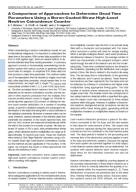Details
- Identification
- ISSN: 1977-5296, DOI: 10.3011/ESARDA.IJNSNP.2017.2
- Publication date
- 1 June 2017
- Author
- Joint Research Centre
Description
Volume: 54, June 2017, pages 6-13,
Authors: A.T. Simone1,2, S. Croft2, A. Favalli3, and J. P. Hayward1,2
1University of Tennessee, Department of Nuclear Engineering, 2Oak Ridge National Laboratory, 3Los Alamos National Laboratory
Abstract:
When characterizing a neutron coincidence counter for use in international safeguards, it is important to understand the dead time of the system. With current data acquisition in the form of shift register logic, there are several options to determine effective dead time model parameters. A customary approach consists of incrementally overwhelming the detection system with various sources to generate different count rates for analysis. An empirical fit to these data can then produce a dead time parameter. This method makes use of the expectation that the doubles to singles count rate ratio, after dead time correction, should remain fixed. In our measurements, we begin with a single 252Cf source and successively combine it with 1, 2, 3, and 4 AmLi (α,n) sources. The time-correlated fission neutrons from the 252Cf are detected by the neutron coincidence counter, and the random- in-time neutrons produced from the multiple AmLi sources provide excess counts to trigger on. Another recently reported approach [12] consists of utilizing the neutron- count number distribution, for a number of counting cycles, to permit a statistical analysis and subsequent determination of the dead time along with a robust estimate of the statistical uncertainty. Moments of several orders can be used; therefore, several estimates of the effective dead time parameter are obtained. In the results reported here, two and four AmLi sources are measured simultaneously within the well of the counter for a number of cycles. We have selected 24 cycles of 300 s each, with predetermined timing gates, where detected neutron multiplicities can range up to approximately 10 neutrons per cycle. These two methods were tested at Oak Ridge National Laboratory using a Boron Coated Straw High-Level Neutron Coincidence Counter, but the methods are also applicable to 3He counters. In this paper, we compare the results of these approaches and discuss the relevance of both.
Keywords: Dead time correction; boron coated straws; high-level neutron coincidence counter; neutron coincidence counting; shift register
Reference guideline:
Simone, A.T., Croft, S., Favalli, A., & Hayward, J.P. (2017). A Comparison of Approaches to Determine Dead Time Parameters Using a Boron-Coated-Straw High-Level Neutron Coincidence Counter. ESARDA Bulletin - The International Journal of Nuclear Safeguards and Non-proliferation, 54, 6-13. https://doi.org/10.3011/ ESARDA.IJNSNP.2017.2

